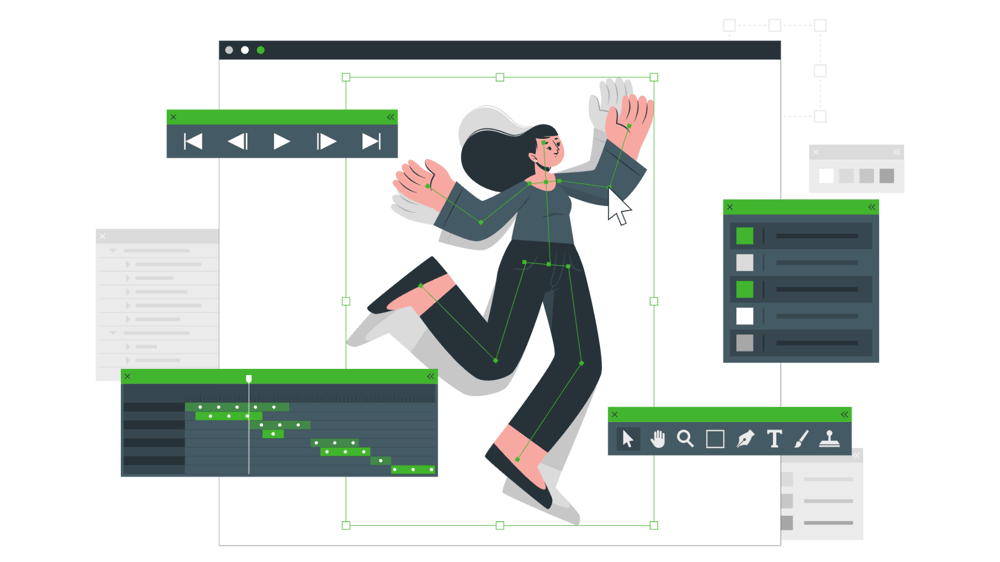Share this
Transforming Learning with Dynamic Motion Graphics
by Batuhan Ünlü on Oct 12, 2023 9:18:43 AM
An Engaging Path to Learning
Have you ever wondered how motion graphics can make your learning more fun and effective? Motion graphics are animated visuals that bring static content to life. They can be used to explain complex concepts, tell engaging stories, and simplify abstract ideas. In this blog, we will show you how motion graphics can transform your learning experience and why you should use them in your education.
In the digital age, education is no longer confined to textbooks and chalkboards. The integration of technology in the learning process has opened up a world of possibilities, and one such captivating tool is motion graphics. Motion design is the art of bringing static elements to life through animation, and has revolutionized education by making complex concepts visually appealing and engaging. In this blog, we will explore the relationship between motion graphics and education and how it is transforming the way we learn.
1. Visual Brillance: Bringing to Life
Motion graphics add a new dimension to education by infusing life into static content. Complex theories and abstract concepts can be presented in a visually appealing manner, making them easier to grasp and retain. Students no longer have to struggle with deciphering complex diagrams or imagining dynamic processes; instead, they can watch as the animations unfold before their eyes, creating a lasting impact on their understanding.

2. Engaging Storytelling: Captivating the Learner
We all love a good story, and motion graphics leverage this innate human preference to captivate learners. By incorporating storytelling techniques, educational content becomes more relatable and enjoyable. Animated characters, narratives, and scenarios help students connect with the subject matter on a deeper level, fostering curiosity and encouraging active participation.

3. Simplifying Complex Concepts: The Power of Visual Metaphors
Motion graphics excel at simplifying intricate concepts through visual metaphors. Abstract ideas that may seem daunting in traditional formats are broken down into relatable visuals. This enables students to grasp difficult subjects without feeling overwhelmed. Whether it's explaining the intricacies of cellular processes or illustrating historical events, visual metaphors serve as powerful tools in the educator's arsenal.

4.Interactive Learning: Empowering Students
Motion graphics offer more than just passive viewing; they provide opportunities for interactive learning experiences. With the integration of motion design in digital learning platforms, students can actively engage with the content. Interactive quizzes, virtual simulations, and gamification elements make the learning journey exciting and empowering, allowing students to take charge of their education.

5. Inclusivity and Accesibility: Reaching Every Learner
Education should be accessible to all, regardless of individual learning preferences or challenges. Motion graphics contribute to inclusivity by catering to various learning styles. Visual learners benefit from the vibrant animations, while auditory learners can absorb information through accompanying narration or sound effects. Additionally, learners with disabilities find motion graphics more accommodating, breaking barriers to learning.

6. Popularity and Effectiveness of Video as a Learning Medium
In the contemporary landscape of education, the popularity and effectiveness of video as a learning medium cannot be overstated. A study by TechSmith reveals compelling insights into this phenomenon, stating that 98% of people say they have watched an explainer video to learn about a product or service, and 68% of people say they would most likely share a video if it is informative. These statistics showcase the immense appeal and impact of video-based learning resources.
Video-based learning materials, including motion graphics, are not only engaging but also highly efficient in conveying information. As highlighted earlier, motion graphics simplify complex concepts through visual metaphors, making them accessible and comprehensible to learners. This aligns with the broader trend of utilizing video content to enhance educational experiences. Students and learners of all ages are increasingly turning to video as a means to grasp difficult subjects, and the data from TechSmith's study reaffirms this trend.

Conclusion
In conclusion, motion graphics have ushered in a new era of education by making learning a visually stunning and immersive experience. Through captivating visual storytelling, interactive elements, and the power of visual metaphors, motion design bridges the gap between educators and learners, inspiring curiosity and a thirst for knowledge. It promotes inclusivity and accessibility, ensuring that education is a rewarding journey for every student. As we continue to embrace technology in education, let us remember the transformative potential of motion graphics. As educators and learners alike, let's explore the dynamic world of motion design and unlock its full potential in shaping the minds of the future. Together, we can embark on an engaging path to learning that will revolutionize education for generations to come.
Share this
- January 2025 (1)
- December 2024 (18)
- November 2024 (21)
- May 2024 (1)
- April 2024 (1)
- March 2024 (1)
- January 2024 (1)
- December 2023 (2)
- November 2023 (2)
- October 2023 (1)
- September 2023 (3)
- August 2023 (2)
- July 2023 (1)
- May 2023 (1)
- April 2023 (1)
- January 2023 (2)
- December 2022 (4)
- November 2022 (2)
- October 2022 (3)
